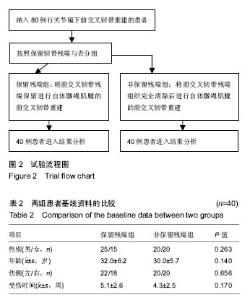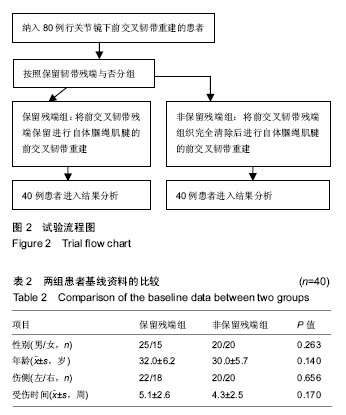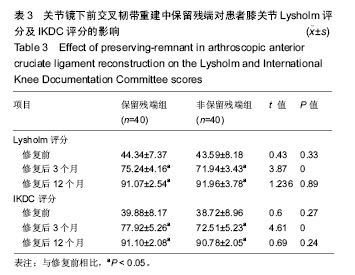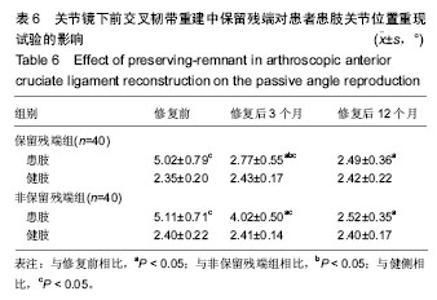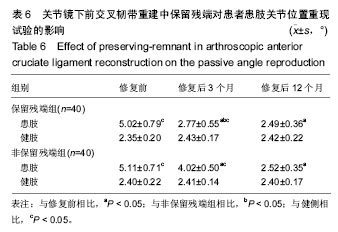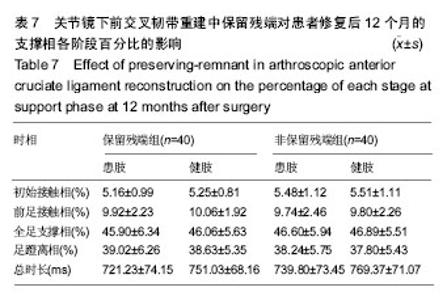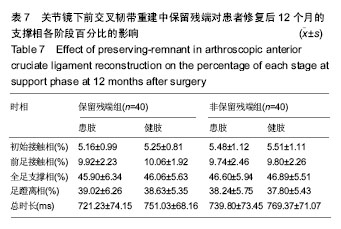Chinese Journal of Tissue Engineering Research ›› 2019, Vol. 23 ›› Issue (4): 525-531.doi: 10.3969/j.issn.2095-4344.1033
Previous Articles Next Articles
Significance of preserving anterior cruciate ligament stump for the stability of knee joint
Feng Xinyuan, Bai Lunhao
- Department of Orthopedics, Shengjing Hospital of China Medical University, Shenyang 110004, Liaoning Province, China
-
Online:2019-02-08Published:2019-02-08 -
Contact:Bai Lunhao, Professor, Doctoral supervisor, Department of Orthopedics, Shengjing Hospital of China Medical University, Shenyang 110004, Liaoning Province, China -
About author:Feng Xinyuan, Master candidate, Department of Orthopedics, Shengjing Hospital of China Medical University, Shenyang 110004, Liaoning Province, China
CLC Number:
Cite this article
Feng Xinyuan, Bai Lunhao. Significance of preserving anterior cruciate ligament stump for the stability of knee joint [J]. Chinese Journal of Tissue Engineering Research, 2019, 23(4): 525-531.
share this article
Add to citation manager EndNote|Reference Manager|ProCite|BibTeX|RefWorks
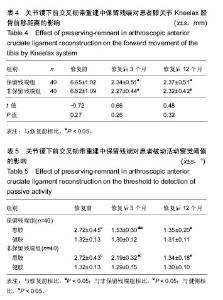
2.3 膝关节前后稳定性 2组患者修复前后患膝Kneelax胫骨前移距离,见表4。修复后3个月及修复后12个月保留残端组与非保留残端组患者胫骨前移度无明显差异(P > 0.05),均获得良好的前后稳定性。 2.4 膝关节本体感觉 2.4.1 膝关节被动活动察觉阈值 两组患者修复前、修复后3个月、修复后12个月患肢健肢的膝关节被动活动察觉阈值的比较,见表5。修复后3个月保留残端组被动活动察觉阈值小于非保留残端组(P < 0.05);修复后12个月时保留残端组与非保留残端组被动活动察觉阈值接近(P > 0.05);保留残端组与非保留残端组患者修复后3个月时患侧被动活动察觉阈值高于健侧(P < 0.05),修复后12个月时2组两侧被动活动察觉阈值接近(P > 0.05)。"
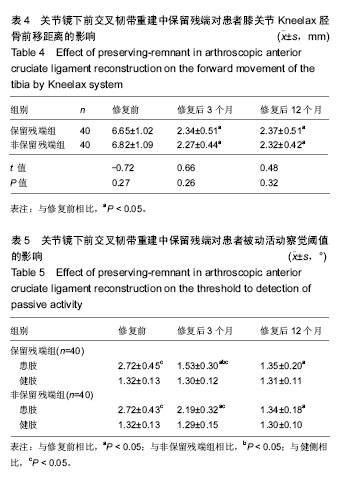
| [1] Duthon VB, Barea C, Abrassart S, et al. Anatomy of the anterior cruciate ligament. Knee Surg Sports Traumatol Arthrosc. 2006;14(3):204-213. [2] Wu B, Zhao Z, Li S, et al. Preservation of remnant attachment improves graft healing in a rabbit model of anterior cruciate ligament reconstruction. Arthroscopy. 2013;29(8):1362-1371. [3] Song GY, Zhang J, Li X, et al. Biomechanical and Biological Findings Between Acute Anterior Cruciate Ligament Reconstruction With and Without an Augmented Remnant Repair: A Comparative in Vivo Animal Study. Arthroscopy. 2016;32(2):307-319. [4] Zhang L, Qi J, Zeng Y, et al. Proprioceptive Changes in Bilateral Knee Joints Following Unilateral Anterior Cruciate Ligament Injury in Cynomolgus Monkeys. Med Sci Monit. 2018;24:105-113. [5] Andonovski A, Topuzovska S, Samardziski M, et al. The Influence of Anterior Cruciate Ligament Remnant on Postoperative Clinical Results in Patients with Remnant Preserving Anterior Cruciate Ligament Reconstruction. Open Access Maced J Med Sci. 2017;5(5):624-629. [6] Lowe WR, Warth RJ, Davis EP, et al. Functional Bracing After Anterior Cruciate Ligament Reconstruction: A Systematic Review. J Am Acad Orthop Surg. 2017;25(3): 239-249. [7] Kirizuki S, Matsumoto T, Ueha T, et al. The Influence of Ruptured Scar Pattern on the Healing Potential of Anterior Cruciate Ligament Remnant Cells. Am J Sports Med. 2018; 46(6):1382-1388. [8] Naraoka T, Kimura Y, Tsuda E, et al. Is Remnant Preservation Truly Beneficial to Anterior Cruciate Ligament Reconstruction Healing? Clinical and Magnetic Resonance Imaging Evaluations of Remnant-Preserved Reconstruction. Am J Sports Med. 2017;45(5):1049-1058. [9] 宋关阳.有关膝关节保留残端前交叉韧带重建的相关研究[D]. 北京:清华大学,2016.[10] 于长隆,曲绵域.实用运动医学[M].北京:北京大学医学出版社, 2003:482-483.[11] Wirth B, Liffert F, de Bruin ED. Development and evaluation of a German version of the Lysholm score for measuring outcome after anterior cruciate ligament injuries. Sportverletz Sportschaden. 2011;25(1):37-43. [12] Hefti F, Müller W, Jakob RP, et al. Evaluation of knee ligament injuries with the IKDC form. Knee Surg Sports Traumatol Arthrosc. 1993;1(3-4):226-234. [13] 黄萍,钱念东,齐进,等.膝骨关节炎患者膝关节置换术后足底压力研究[J].中国运动医学杂志,2018,37(3):197-201[14] Bastin J, Calvin S, Montagne G. Muscular proprioception contributes to the control of interceptive actions. J Exp Psychol Hum Percept Perform. 2006;32(4):964-972. [15] Dhillon MS, Bali K, Prabhakar S. Proprioception in anterior cruciate ligament deficient knees and its relevance in anterior cruciate ligament reconstruction. Indian J Orthop. 2011;45(4): 294-300. [16] 陈均源,王华军,罗斯敏,等.前交叉韧带重建本体感觉恢复影响因素分析[J].中国矫形外科杂志,2016,24(24):2264-2268.[17] Kim HJ, Lee JH, Lee DH. Proprioception in Patients With Anterior Cruciate Ligament Tears: A Meta-analysis Comparing Injured and Uninjured Limbs. Am J Sports Med. 2017;45(12): 2916-2922. [18] Dhillon MS, Bali K, Vasistha RK. Immunohistological evaluation of proprioceptive potential of the residual stump of injured anterior cruciate ligaments (ACL). Int Orthop. 2010; 34(5):737-741. [19] Bali K, Dhillon MS, Vasistha RK, et al. Efficacy of immunohistological methods in detecting functionally viable mechanoreceptors in the remnant stumps of injured anterior cruciate ligaments and its clinical importance. Knee Surg Sports Traumatol Arthrosc. 2012;20(1):75-80. [20] Riemann BL, Lephart SM. The Sensorimotor System, Part II: The Role of Proprioception in Motor Control and Functional Joint Stability. J Athl Train. 2002;37(1):80-84. [21] Lee BI, Min KD, Choi HS, et al. Immunohistochemical study of mechanoreceptors in the tibial remnant of the ruptured anterior cruciate ligament in human knees. Knee Surg Sports Traumatol Arthrosc. 2009;17(9):1095-1101. [22] Kosy JD, Mandalia VI. Anterior Cruciate Ligament Mechanoreceptors and their Potential Importance in Remnant-Preserving Reconstruction: A Review of Basic Science and Clinical Findings. J Knee Surg. 2018;31(8): 736-746. [23] Ahn JH, Wang JH, Lee YS, et al. Anterior cruciate ligament reconstruction using remnant preservation and a femoral tensioning technique: clinical and magnetic resonance imaging results. Arthroscopy. 2011;27(8):1079-1089. [24] Crain EH, Fithian DC, Paxton EW, et al. Variation in anterior cruciate ligament scar pattern: does the scar pattern affect anterior laxity in anterior cruciate ligament-deficient knees? Arthroscopy. 2005;21(1):19-24. [25] Muneta T, Koga H. Anterior cruciate ligament remnant and its values for preservation. Asia Pac J Sports Med Arthrosc Rehabil Technol. 2016;7:1-9. [26] Zhang S, Matsumoto T, Uefuji A, et al. Anterior cruciate ligament remnant tissue harvested within 3-months after injury predicts higher healing potential. BMC Musculoskelet Disord. 2015;16:390. [27] Angoules AG, Mavrogenis AF, Dimitriou R, et al. Knee proprioception following ACL reconstruction; a prospective trial comparing hamstrings with bone-patellar tendon-bone autograft. Knee. 2011;18(2):76-82. [28] Furlanetto TS, Peyré-Tartaruga LA, do Pinho AS, et al. Proprioception, body balance and functionality in individuals with acl reconstruction. Acta Ortop Bras. 2016;24(2):67-72.[29] Gohil S, Annear PO, Breidahl W. Anterior cruciate ligament reconstruction using autologous double hamstrings: a comparison of standard versus minimal debridement techniques using MRI to assess revascularisation. A randomised prospective study with a one-year follow-up. J Bone Joint Surg Br. 2007;89(9):1165-1171. [30] Ahn JH, Lee SH, Choi SH, et al. Magnetic resonance imaging evaluation of anterior cruciate ligament reconstruction using quadrupled hamstring tendon autografts: comparison of remnant bundle preservation and standard technique. Am J Sports Med. 2010;38(9):1768-1777. [31] Li B, Wang GB, Wang YF, et al. Effects of pre-operative knee laxity on clinical outcomes after partial anterior cruciate ligament reconstruction. Knee. 2018;25(3):445-452. [32] An KO, Park GD, Lee JC. Effects of acceleration training 24 weeks after anterior cruciate ligament reconstruction on proprioceptive and dynamic balancing functions. J Phys Ther Sci. 2015;27(9):2825-2828. [33] Park JH, Jeong WK, Lee JH, et al. Postural stability in patients with anterior cruciate ligament tears with and without medial meniscus tears. Knee Surg Sports Traumatol Arthrosc. 2015; 23(1):240-245. [34] Nakamae A, Ochi M, Deie M, et al. Biomechanical function of anterior cruciate ligament remnants: how long do they contribute to knee stability after injury in patients with complete tears? Arthroscopy. 2010;26(12):1577-1585. [35] Takahashi T, Kondo E, Yasuda K, et al. Effects of Remnant Tissue Preservation on the Tendon Graft in Anterior Cruciate Ligament Reconstruction: A Biomechanical and Histological Study. Am J Sports Med. 2016;44(7):1708-1716. [36] Tie K, Chen L, Hu D, et al. The difference in clinical outcome of single-bundle anterior cruciate ligament reconstructions with and without remnant preservation: A meta-analysis. Knee. 2016;23(4):566-574. [37] 许锦煌,黄建荣,尹萍,等.保留残端对前交叉韧带重建术后恢复的临床意义[J].中国临床解剖学杂志,2015,33(5):584-587.[38] Lee BI, Kwon SW, Kim JB, et al. Comparison of clinical results according to amount of preserved remnant in arthroscopic anterior cruciate ligament reconstruction using quadrupled hamstring graft. Arthroscopy. 2008;24(5):560-568. [39] Hexter AT, Thangarajah T, Blunn G, et al. Biological augmentation of graft healing in anterior cruciate ligament reconstruction. Bone Joint J. 2018;100-B(3):271-284. [40] Lee BI, Min KD, Choi HS, et al. Arthroscopic anterior cruciate ligament reconstruction with the tibial-remnant preserving technique using a hamstring graft. Arthroscopy. 2006;22(3): 340. e1-7. [41] Weninger P, Wepner F, Kissler F, et al. Anatomic Double-Bundle Reinsertion After Acute Proximal Anterior Cruciate Ligament Injury Using Knotless PushLock Anchors. Arthrosc Tech. 2015;4(1):e1-6. |
| [1] | Chen Zehua, Ye Xiangling, Chen Weijian, Du Jianping, Liu Wengang, Xu Xuemeng. Effect of pronated foot posture on proprioception and postural stability based on foot posture index [J]. Chinese Journal of Tissue Engineering Research, 2021, 25(9): 1324-1328. |
| [2] | Zhang Tongtong, Wang Zhonghua, Wen Jie, Song Yuxin, Liu Lin. Application of three-dimensional printing model in surgical resection and reconstruction of cervical tumor [J]. Chinese Journal of Tissue Engineering Research, 2021, 25(9): 1335-1339. |
| [3] | Zeng Yanhua, Hao Yanlei. In vitro culture and purification of Schwann cells: a systematic review [J]. Chinese Journal of Tissue Engineering Research, 2021, 25(7): 1135-1141. |
| [4] | Liu Shaohua, Zhou Guanming, Chen Xicong, Xiao Keming, Cai Jian, Liu Xiaofang. Influence of anterior cruciate ligament defect on the mid-term outcome of fixed-bearing unicompartmental knee arthroplasty [J]. Chinese Journal of Tissue Engineering Research, 2021, 25(6): 860-865. |
| [5] | Xu Dongzi, Zhang Ting, Ouyang Zhaolian. The global competitive situation of cardiac tissue engineering based on patent analysis [J]. Chinese Journal of Tissue Engineering Research, 2021, 25(5): 807-812. |
| [6] | Wu Zijian, Hu Zhaoduan, Xie Youqiong, Wang Feng, Li Jia, Li Bocun, Cai Guowei, Peng Rui. Three-dimensional printing technology and bone tissue engineering research: literature metrology and visual analysis of research hotspots [J]. Chinese Journal of Tissue Engineering Research, 2021, 25(4): 564-569. |
| [7] | Ma Ziyue, Ju Xiaochen, Zhang Lei, Sun Rongxin. Tendon-bone healing in anterior cruciate ligament reconstruction with and without remnant preservation [J]. Chinese Journal of Tissue Engineering Research, 2021, 25(4): 582-587. |
| [8] | Chang Wenliao, Zhao Jie, Sun Xiaoliang, Wang Kun, Wu Guofeng, Zhou Jian, Li Shuxiang, Sun Han. Material selection, theoretical design and biomimetic function of artificial periosteum [J]. Chinese Journal of Tissue Engineering Research, 2021, 25(4): 600-606. |
| [9] | Liu Fei, Cui Yutao, Liu He. Advantages and problems of local antibiotic delivery system in the treatment of osteomyelitis [J]. Chinese Journal of Tissue Engineering Research, 2021, 25(4): 614-620. |
| [10] | Li Xiaozhuang, Duan Hao, Wang Weizhou, Tang Zhihong, Wang Yanghao, He Fei. Application of bone tissue engineering materials in the treatment of bone defect diseases in vivo [J]. Chinese Journal of Tissue Engineering Research, 2021, 25(4): 626-631. |
| [11] | Zhang Zhenkun, Li Zhe, Li Ya, Wang Yingying, Wang Yaping, Zhou Xinkui, Ma Shanshan, Guan Fangxia. Application of alginate based hydrogels/dressings in wound healing: sustained, dynamic and sequential release [J]. Chinese Journal of Tissue Engineering Research, 2021, 25(4): 638-643. |
| [12] | Chen Jiana, Qiu Yanling, Nie Minhai, Liu Xuqian. Tissue engineering scaffolds in repairing oral and maxillofacial soft tissue defects [J]. Chinese Journal of Tissue Engineering Research, 2021, 25(4): 644-650. |
| [13] | Xing Hao, Zhang Yonghong, Wang Dong. Advantages and disadvantages of repairing large-segment bone defect [J]. Chinese Journal of Tissue Engineering Research, 2021, 25(3): 426-430. |
| [14] | Chen Siqi, Xian Debin, Xu Rongsheng, Qin Zhongjie, Zhang Lei, Xia Delin. Effects of bone marrow mesenchymal stem cells and human umbilical vein endothelial cells combined with hydroxyapatite-tricalcium phosphate scaffolds on early angiogenesis in skull defect repair in rats [J]. Chinese Journal of Tissue Engineering Research, 2021, 25(22): 3458-3465. |
| [15] | Wang Hao, Chen Mingxue, Li Junkang, Luo Xujiang, Peng Liqing, Li Huo, Huang Bo, Tian Guangzhao, Liu Shuyun, Sui Xiang, Huang Jingxiang, Guo Quanyi, Lu Xiaobo. Decellularized porcine skin matrix for tissue-engineered meniscus scaffold [J]. Chinese Journal of Tissue Engineering Research, 2021, 25(22): 3473-3478. |
| Viewed | ||||||
|
Full text |
|
|||||
|
Abstract |
|
|||||
